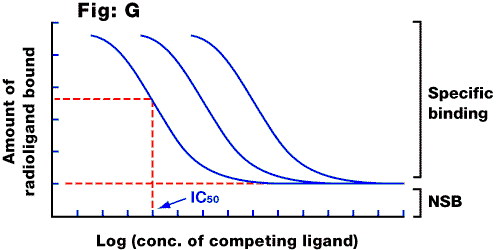Receptor binding techniques: competition (inhibition or displacement) assays

Fig. G: Competition curves for a series of compounds in a binding assay. The NSB is the non-specific binding, i.e. the fraction which is not displaced by other ligands for the receptor. See below for the definition of the IC50.
Competition assay
In this type of assay, a single concentration of radioligand is used in every assay tube
(unlike the saturation experiment, in which the radioligand concentration is varied). The
ligand is used at a low concentration, usually at or below its KD value. The level of
specific binding of the radioligand is then determined in the presence of a range of
concentrations of other competing non-radioactive compounds, in order to measure the
potency with which they compete for the binding of the radioligand. Competition curves may
also be computer-fitted to a logistic function as described under direct fit.
IC50
The concentration of competing ligand which displaces 50% of the specific binding of the
radioligand. The IC50 value is converted to an absolute inhibition constant Ki)
using the Cheng-Prusoff equation (see Ki).
Ki
The inhibition constant for a drug; the concentration of competing ligand in a competition
assay which would occupy 50% of the receptors if no radioligand were present. Whereas the
IC50 value for a compound may vary between experiments depending on radioligand
concentration, the Ki is an absolute value. It is calculated from the IC50
using the Cheng-Prusoff equation:
IC50
Ki = ------------
1 + ([L]/KD)
where [L] = the concentration of free radioligand used in the assay, and KD = the dissociation constant of the radioligand for the receptor. The Ki value for an antagonist should theoretically equal the KB value determined in an in vitro experiment where a functional response is measured, provided that assay conditions are similar.
nH
The slope of the Hill plot; the Hill coefficient. See Hill
analysis.
NSB
Abbreviation for non-specific binding. It is the proportion of radioligand binding which
is not displaced by other drugs specific for the receptor. It may consist of binding to
other receptor types, to other proteins in the membrane, partitioning into lipids, or many
other things. It is determined experimentally using a saturating concentration of a drug
which, ideally, is chemically dissimilar to the radioligand but is specific for the same
receptor.
pKi
The negative log of the Ki value. The pKi value for an antagonist
should theoretically equal its pKB value at the same receptor, determined in an
in vitro experiment.
Further information is available on receptor binding, including a useful radioactivity calculator for biochemical and pharmacological experiments.
![]() Saturation analysis
Saturation analysis
![]() Table of Contents
Table of Contents
 |
 |
 |
 |
 |
 |
 |